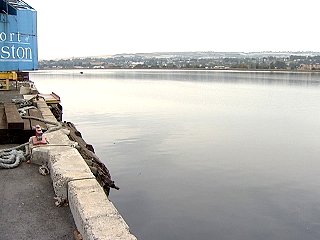forum
library
tutorial
contact

Sediment Buildup Complicates Fish Care,
Navigation at Lower Granite Dam
by Laura Berg
NW Fishletter, September 5, 2017
|
the film forum library tutorial contact |

|
Sediment Buildup Complicates Fish Care,
by Laura Berg
|
 Higher-than-expected sediment buildup this summer on the lower Snake River near the Port of Clarkston, Wash., has led the port to request a one-foot increase of the Lower Granite reservoir's minimum operating pool (MOP) for 11 hours, from 6:00 a.m. to 5:00 p.m. on Aug. 15, to accommodate the scheduled mooring of a deeper-draft cruise boat.
Higher-than-expected sediment buildup this summer on the lower Snake River near the Port of Clarkston, Wash., has led the port to request a one-foot increase of the Lower Granite reservoir's minimum operating pool (MOP) for 11 hours, from 6:00 a.m. to 5:00 p.m. on Aug. 15, to accommodate the scheduled mooring of a deeper-draft cruise boat.
Port of Clarkston Manager Wanda Keefer made the pitch for the increase at the Technical Management Team meeting on Aug. 9, as a formal system operation request (SOR) to the action agencies and the multi-agency Technical Management Team. The Federal Columbia River Power System BiOp requires an SOR process for such a change to be made.
Possibly in anticipation of opposition, the port director made a case for the tourist traffic, saying cruise boats visiting the Lewis-Clark Valley bring some 27,000 foreign and domestic visitors and crew and about $2 million annually to the local economy.
Action agency representatives from both the BPA and U.S. Army Corps of Engineers. however, and state, tribal and federal salmon managers seemed to want to figure out how to accommodate the change in MOP.
Rather than resistance, what was on display at the TMT meeting was on-the-fly, real-time adaptive management, even if more improvised than most members would have it.
Salmon manager representatives pressed dam operators for information about how the change would affect conditions for migrating salmon and steelhead now in the river.
Doug Baus, U.S. Army Corps of Engineers' biologist and TMT convener, responded that higher pool elevation would reduce flows, which would result in less flow for electric generation and for spill.
Jay Hesse, research biologist and TMT member for the Nez Perce Tribe, emphasized the need to continue spill for the remaining juvenile fall Chinook making their way to the ocean. "There are," he said, "still a thousand juvenile fish a day, not an insignificant number."
Noting the increasing number of adult Chinook and steelhead moving upstream, Hesse asked Baus about the effects changes in pool elevation would have on water temperatures in the dam's tailrace and in the stratification of river temperatures.
Baus said there would be very little change in water temperatures.
This time of year in the lower Snake River, juvenile fall Chinook and juvenile Pacific lamprey are migrating downstream to the ocean, while adult Chinook and steelhead are migrating upstream to spawning areas.
Returning to the need for spill, Hesse said that spill was particularly critical since the juvenile bypass system is no longer available at Lower Granite since the submersible screens (that block young fish from the turbines and divert them into a bypass route) have been removed for the season.
Charles Morrill, biologist and Washington's TMT representative, urged the Corps and BPA to make the operational MOP adjustment in a spill-neutral manner.
Stretching out the changes in reservoir elevations would minimize the spill deferential, Baus said. This time of year, the challenge is low inflows and variable flows, he said.
"We'll need three days to get the water in," BPA's Tony Norris said, "and three days to get the water out." Norris is a BPA analyst and TMT member.
"The only way to do it is not to go above minimum generation," he said. "But if Idaho Power releases more water than planned, it could change the dates," he added.
In response to questions by Columbia River Inter-Tribal Fish Commission engineer Tom Lorz, Baus acknowledged that unit upgrades were occurring at Lower Granite. "Some units being off and on will happen," he said. Lorz represents the Confederated Tribes of the Umatilla Reservation at TMT.
Anne Setter, Corps Walla Walla District biologist, indicated that unit availability became more complicated at the dam several days ago when the Unit 3 fish screen got stuck during attempts to remove it.
The expectation had been that Lower Granite's Unit 3 would be used during the modification in MOP because it operates at lower output than other units, thus leaving more water to exit the dam as spill.
Oregon's TMT representative, biologist Erick Van Dyke, said the work on generating units was a new development and that "unit priority was more problematic than 11 hours' change in MOP."
After more deliberation and a six-hour delay while Oregon made its decision on how to vote on the proposed system operation request, TMT members allowed the SOR to go forward with the caveat that action agencies would make the MOP change in as spill-neutral a manner as possible. Members voted to approve, did not object or abstained.
Not long after Oregon decided to abstain from voting, the Lower Granite Unit 3 screen was successfully removed.
Related Pages:
Snake River Sediment Buildup May Be Slowing by Associated Press, Seattle Times, November 9, 2008
learn more on topics covered in the film
see the video
read the script
learn the songs
discussion forum
